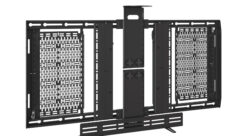
Designing A Mix-Minus Distributed Sound System
How to avoid feedback while delivering acceptable amplification levels.
Unlike a rock concert, where the performers hold the microphones very close to their mouths, the conference room can have fairly large Ds (microphone to source) distances. Poor design trends such as ceiling microphones or microphones mounted in the table 4 to 6 feet away from the talkers can have very damaging effects on local sound reinforcement. Moving a microphone 6 inches to 6 feet away from the talker will result in a loss of PAG of more than 21 dB. Add the close proximity of the loudspeakers — generally mounted overhead in the low ceiling —and PAG falls below failure limits, increasing the likelihood of feedback.Loudspeaker 1 (S1), directly over microphone 1 (M1), will generate feedback even at fairly low amplification levels. If we use mix-minus, M1 isn’t mixed to S1. Instead, it’s mixed only to the farther loudspeakers in the room. In essence, we’ve increased D1, thus improving the PAG of the system (Fig. 2).These calculations in the examples so far apply only to the distance relationship between M1 and all of the loudspeakers. The same calculations should be made for each microphone-to-loudspeaker relationship. Mix-minus systems introduce the term “crosspoint gain.” Each microphone-to-loudspeaker combination (M3 to S4, M7 to S8) is a crosspoint — the virtual audio intersection of one input to one output. Each crosspoint can have a different gain structure based on the distance of the microphone from the loudspeaker. A large mix-minus system will have a matrix of inputs to outputs with a different level for each crosspoint. If the system has 16 inputs to 16 outputs, the matrix will have 256 crosspoints (16 times 16). In Fig. 4, you can see the different levels a microphone in the middle of the table will have in relation to the different loudspeakers.Can a mix-minus design overcome the ceiling microphone problem? To a degree, mix-minus can improve the severe gain limitations imposed by ceiling microphones. However, there are some serious limitations. Take a close look at the ceiling microphone system shown in Fig. 5.Remember, all a mix-minus system does is affect the D1 distance in the PAG formula. Feedback is a function of acoustical physics. You can’t buy nor bend the laws of physics, and a poorly designed system generally attempts to do just that. If you keep your design simple, and don’t try to push the design envelope too hard, mix-minus can take a marginally functional room into the realm of full functionality. Now, if only mix-minus could fix bad slide presentations….
It’s no secret that conference rooms have long held challenges for local amplification due to low ceilings, distant microphones, and at times, poor acoustics. Aesthetic considerations such as “invisible” microphones and loudspeakers have sometimes taken priority over technical issues such as potential acoustical gain (PAG). The challenge for AV systems integration firms is meeting the visual requirements of the client while adhering to proper systems design that still obeys the laws of physics.
Why is this design objective so difficult to attain in a typical conference room? Because feedback is a function of acoustical distance. PAG is the theoretical limit a sound system can achieve before feedback. A simplified open field mathematical formula illustrates the basic factors involved in generating feedback.
PAG= 20log((D0* D1)/(D2 Ds)-6dBfsm-10log(NOM))
D0 = distance of the talker (or source) to the farthest listener
D1 = distance of the microphone to the nearest loudspeaker carrying the microphone signal
D2 = distance of the closest loudspeaker to the listener Ds = distance of the microphone to the talker (source)
6 dBfsm is the feedback stability margin
NOM is the number of open microphones
Note that this formula doesn’t take into account anything electronic. Instead, it’s simply based on the distance relationships of the various parts of an amplified system to each other. If the loudspeaker is closer to the listener, PAG increases. If the microphone is closer to the talker, PAG increases. If the loudspeaker gets farther from the microphone, then PAG is increased. Opposite changes will decrease gain. These fundamental relationships are the key source of problems in conference rooms.
One of the tools available to the system designer is the use of the mix-minus loudspeaker system, an arrangement that derives its name from the fact that each loudspeaker will have a full mix of the microphones in the room minus the microphones that are close enough to that loudspeaker to generate feedback. The concept isn’t new to audio system design — a good monitor engineer will tell you that he can get excellent gain before feedback with a musician who doesn’t insist on hearing his own voice in the monitors. When the performer’s voice isn’t part of the mix, the monitor loudspeaker can be significantly louder.
What are the advantages of a mix-minus design? First, the system will have improved gain before feedback. It will also perform at louder levels and improve intelligibility for meeting participants. The mix-minus design can overcome some visual design issues. In some cases, it can even allow a ceiling microphone system to work better.
The underlying concept behind mix-minus systems in conference room design has been around for several years using various methods. Loudspeaker ducking was a popular method where the local loudspeaker near a microphone would be automatically attenuated or turned off by a bank of relays whenever the microphone was activated.
The disadvantage was the inability for two people to talk at the same time, especially to each other. Because their loudspeakers would be turned off, they wouldn’t be able to hear the other person speaking.
In a “Robert’s Rules of Order” environment, this method worked. But if the conference featured many people talking simultaneously, the ducking was a distraction and therefore worked against the team dynamics.
Mix-minus essentially manipulates PAG by changing D1 in the formula. If a microphone isn’t mixed into the loudspeakers in close proximity, then D1 is increased and PAG improves. Here’s an example. In a theoretical boardroom, the microphones are on the table, and the loudspeakers are directly overhead each seating position (Fig. 1 on page 47).
Let’s take that concept a bit further. First, establish a reference distance where the level of the microphone would be at its loudest. Logically, that would be at the farthest loudspeaker from the microphone. Accordingly, the closer loudspeakers could be mixed at decreasing levels as they get closer to the microphone.
This can be calculated according to the following formula:
Ld=20(Dx/Dr) where
Ld is the reduction in level expressed in decibels (generally a negative number)
Dx is the distance of the loudspeaker for which you’re calculating the reduction in gain
Dr is the distance of the reference (farthest) loudspeaker.
Now we can calculate the gain reduction for each loudspeaker (as related to M1). Acoustically, this means that when a signal from M1 is generated, the SPL level at each loudspeaker (as measured at the microphone position) will be the same. In the PAG formula, this would be considered equivalent acoustical distance (EAD). All loudspeakers, as heard at M1, will be at the same level.
If we set the level for M1 at these calculated levels to each loudspeaker, there will be more even coverage of M1, allowing all participants to hear. Note that the level in the room generated by each loudspeaker will be cumulative. The final overall gain will still be lower than a single loudspeaker carrying the signal at the reference distance (Fig. 3).
Together, all of the microphones — each at their own individual levels to a loudspeaker — represent the final mix sent to that loudspeaker. Someone sitting under S1 at the head of the table won’t hear his own voice coming from his overhead loudspeaker, but everyone else in the room will hear him clearly, as he’ll hear each of them as they’re mixed into his loudspeaker.
In this case, the ceiling microphones are located so closely to the loudspeakers that they’ll “hear” the loudspeakers at even a low volume level long before they pick up a human voice from the table. For mix-minus to work properly, the microphones must still be closer to the source than to any nearby loudspeaker. For this system to work, greater loudspeaker/microphone spacing and a more sophisticated mix-minus setup will have to be designed (Fig. 6).
M1 is only amplified at full level in loudspeaker four at the far end of the table. S3 carries M1 at a lower level, and S1 and S2 don’t carry M1 at all. The middle microphones will be carried ONLY by the outer loudspeakers at lower levels while M4 distribution will be the mirror image of M1’s.
How do you design/predict the appropriate levels? One of the easiest ways to do this is to construct a spreadsheet that has microphones on the vertical axis and loudspeakers on the horizontal axis. Enter the distance from each loudspeaker to each microphone. In one other cell, enter your reference distance (which is the longest microphone-to-loudspeaker distance in the room). In a second block of cells, calculate the changes in level with the formula 20Log(D1/Dr). D1 is the value of the crosspoint cell. Dr is the value of the reference cell. Format the cells for a numeric answer with no decimal places. The resulting table will give you the appropriate levels for each crosspoint level.
Helpful hint: If the loudspeaker distance is closer than 12 feet, set the crosspoint gain to “off.” Anyone sitting within 12 feet will be close enough to hear without local amplification.
Now you have your theoretical model, but how do you actually realize this concept in your system design? Specialized designs require specialized equipment. Fortunately, modern DSP products easily allow for this kind of design. The product you’ll need will have the ability to mix to multiple outputs from multiple inputs in any combination. An automixing function will help as it maintains the number of open mics (NOM) as always equal to one, thus keeping gain at a maximum in the PAG formula. Choose the DSP device based on your required number of inputs and the required number of outputs. Remember that you’ll need a discrete output for each mix. Six loudspeaker zones? Six mixes. If you built the spreadsheet described earlier, you can plug these levels directly into the crosspoint gain controls in the DSP processor.
Concurrent with the DSP requirement will be the need for a discrete amplifier for each loudspeaker zone. Note that a loudspeaker zone may actually have more than one loudspeaker. It isn’t uncommon for a mix-minus system to have two loudspeakers carrying the same mix in a loudspeaker zone. Be careful about your loudspeaker impedances. Each loudspeaker zone will require a “home” run of the proper loudspeaker cabling back to the amplifiers.
Mix-minus can help in other low-gain systems such as courtrooms. In Fig. 7 on page 66, mix-minus is applied to the judge’s loudspeaker, witness, defense, prosecution, clerk, and jury (with two loudspeakers). The judge gets excellent gain because only her microphone isn’t mixed into her loudspeaker. She easily hears everyone else.
There are drawbacks and limitations to mix-minus — this approach isn’t a cure-all for all low-gain systems. First, it’s still possible to get feedback if microphones are too close to loudspeakers — a situation most often found in ceiling-mounted microphones or desk-mounted loudspeakers. A feedback loop can easily be generated in spite of mix-minus. Here’s an example. M1 is NOT mixed to S1 at all. M7 isn’t mixed to S7. But M1 is amplified at full gain into S7. If S7 is too close to M7, the signal from M1 will be picked up easily by M7, which will then be fed right back to the mix of S1. Through this double pathway, M1 still ends up in the mix for S1, and the gain before feedback is compromised.
The second drawback is added expense. Multiple amplifiers and multiple cable runs for each loudspeaker are required. Using a distributed 70-volt system won’t work because it doesn’t allow for independent mixes to each loudspeaker. Generally, the amplifiers don’t have to be very large, given that each loudspeaker will probably only require about 1/4 watt to deliver the required SPL to the listener.
When is mix-minus no longer a valid solution? If the microphone-to-loudspeaker distance (D1) exceeds 12 to 15 feet, mix-minus may have little effect. Once the loudspeakers get far enough away to reduce the feedback loop, the effectiveness of mix-minus becomes much less apparent. With proper microphone/speaker selection and placement, a high-ceiling room with ceiling loudspeakers can generally work very effectively without mix-minus, and a simpler 70-volt distributed loudspeaker system will work fine.
If the microphones are too far away, (i.e., more than 6 feet, as in high ceilings), then PAG will never be enough — even with an aggressive mix-minus matrix. So that same room discussed in the previous paragraph would be a disaster if the microphones were also mounted in the ceiling.
Gordon Moore is vice president of sales at Lectrosonics. He can be reached at [email protected].










